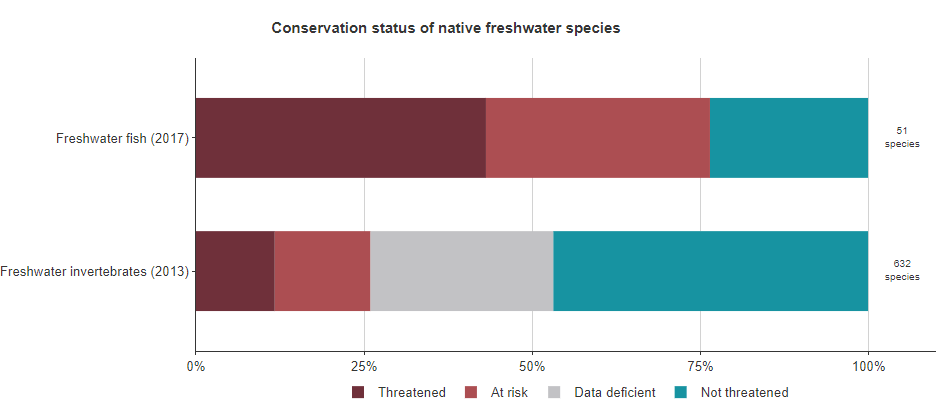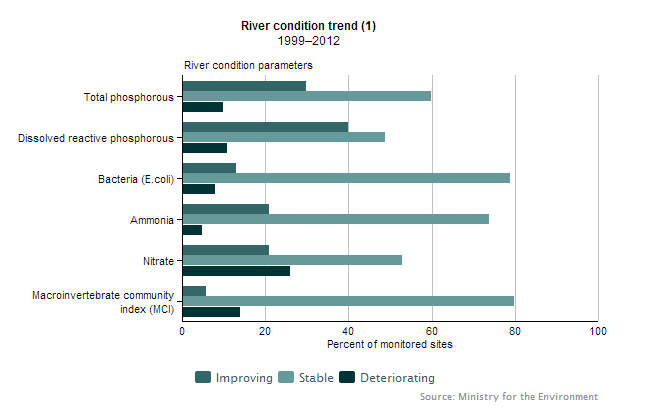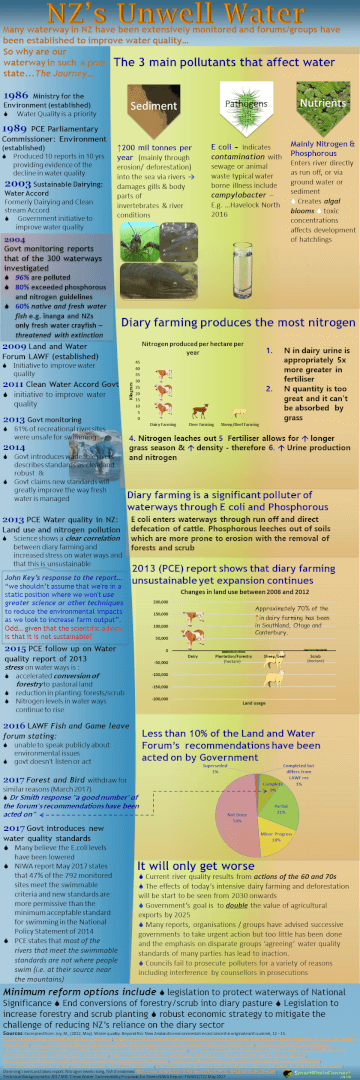River conditions
Ministry of the Environment data on River Conditions 1999-2012
- Concentrations of phosphorus, bacteria, and ammonia were either stable or improving at most monitored sites.
- Nitrate concentrations and macroinvertebrate condition (water insect life) deteriorated at more sites than improved. High concentrations of nitrate can cause excessive aquatic plant growth and are toxic to fish. The composition of macroinvertebrate communities reflects changes in water quality, river habitat, and catchment condition.
NIWA data on water quality trends and status
Status and trends in water quality – NIWASustained national-scale monitoring is fundamental to determining the state of our freshwaters, the impacts of land use changes, and the success of clean-up efforts. The country’s only national-scale monitoring programme, the National Rivers Water Quality Network (NRWQN), is operated by NIWA. The network regularly samples 77 sites, including 35 major rivers that drain 50 percent of our land area.Trends in NRWQN data between 1989 and 2007 (published on the MfE website) show an overall degradation in water quality in our major rivers. Over that period, nitrogen and phosphorus – key plant nutrients added in fertilisers – increased strongly at many sites. Nitrogen increased by about 1.4 percent per annum over most of the country, but remained steady at pristine sites like the Haast River; no sites recorded a drop in nitrogen concentrations (see map).Water quality is appreciably worse at several hundred sites in lowland rivers monitored by regional councils – many rivers show excessive nutrients, reduced visual clarity due to suspended sediments, and pollution by faecal bacteria.
Data on Water Quality - Parliamentary Commissioner for the Environment
The 2018 Parliamentary Commissioner for the Environment report titled – Overseer and regulatory oversight: Models, uncertainty and cleaning up our waterways
The 2013 Parliamentary Commissioner for the Environment report titled – Water Quality in New Zealand – Understanding the Science
The report outlines the three main water pollutants of greatest concern in New Zealand. These are
- pathogens,
- sediment and
- nutrients (mainly phosphorus and nitrogen).
Nitrogen in Rivers
Water Quality and Land Use – Parliamentary Commissioner for the Environment
The amount of nitrogen in rivers is going to get worse …The modelling shows annual nitrogen loads on freshwater continuing to rise in virtually every region.
Figure 7.1 shows:
- how these increasing nitrogen loads correlate with the expansion of dairy farming. Canterbury, Southland, and to a lesser extent, Otago, stand out.
- while the other regions have lesser increases, some, such as Waikato and Manawatū, already have high nitrogen loads and existing water quality problems.
Life in fresh water

Conservation status of native freshwater species
Here’s how we’re doing…its not that good
Of species assessed, 76% of indigenous freshwater fish are classified as threatened with or at risk of extinction
Fish and invertebrate species that are threatened with or at risk of extinction include culturally significant and taonga species such as:
- four of the five whitebait species (shortjaw kōkopu, giant kōkopu, kōaro, and inanga)
- lamprey (kanakana/piharau)
- longfin eel (tuna)
- Stokell’s smelt
- South Island kōura / freshwater crayfish
- all three species of freshwater mussel (kākahi).
There is not enough information to assess the conservation status (classified as data deficient) of 27 percent (172 species) of freshwater invertebrates.
The conservation status has changed between assessment periods for some species
- The conservation status of one freshwater fish (southern flathead galaxias) and three freshwater invertebrates (three species of freshwater snails) worsened between assessment periods (2013–17 and 2005–13, respectively).
- Two conservation-dependent freshwater fish species, longjaw galaxias (Galaxias cobitinis) and Canterbury mudfish (Neochanna burrowsiu), were classified with the highest threat of extinction status ‘Threatened – Nationally critical’. This means they would be expected to become extinct if their current conservation management ceases.
There’s some good news….but not much
- Over the period 2013–17 the conservation status of one freshwater fish (lowland longjaw galaxias) improved.
This information is provided by StatsNZ and DOC
The long fin eel
The case for the Long fin eels
Too much sediment:
- Clear flowing streams with shaded stony beds – a favoured habitat for longfin eels – became open to the sun and smothered in sediment.
- Without roots and overhanging branches, longfin eels lost the shelter and holes in which they made their homes.
Too many nutrients:
- Irrigation often leads to more intensive land use, frequently resulting in greater concentrations of nutrients and sediment in the water and thus poorer water quality.
- It is not the nutrient and sediment levels themselves that are the main problem for eels, who are quite resilient creatures. However the ensuing excessive plant growth can smother the stream bed, reducing both habitat and food for eels and other fish.34 Sometimes toxic algae bloom, which while not killing eels directly, have made eels poisonous to eat.
These are some of the factors that are reducing the long fin eel population. The report provides comprehensive information on all factors that contribute to the reduction in the long fin eel population.Water quality affects whitebaitWater quality affects recreational fishing






